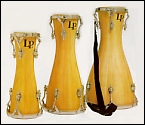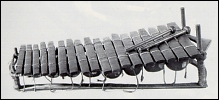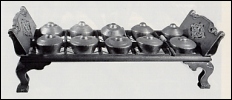

WORLD SOUNDS


WORLD SOUNDS
 |
The Accordion belongs to the free-reed family of instruments, and came into being in Europe early in the eighteenth century. Its origins may be traced back to the Sheng, the mouth organ of the east, which evolved in China about 3,000 years ago. The two main types come with either a right hand chromatic button-board or keyboard, and between 12 and 200 left hand buttons for the counterbasses, basses and chords. The reeds are grouped in pairs, and the single-action instruments produce different notes when the bellows are opened and closed, whereas the two reeds of each pair are tuned to the same note in the double-action type. Other related |
For more information about Accordions, as well as other musical instruments contact Vince Lamberti at VA Lamberti Musical Instruments & Supplies. 24 Johnston Street, Fitzroy, Victoria 3065, Australia. Tel: (61 3) 9486 9411, Fax: (61 3) 9417 1133. I would also like to thank accordionist Giuseppe Costanzo for supplying information.
ANDRIÁN PERTOUT
'Mixdown' Monthly ~ Issue #33, January 1, 1997
BEAT MAGAZINE PTY LTD
All rights reserved. All text,
graphics and sound files on this page are copyrighted.
Unauthorized reproduction and
copying of this page is prohibited by law. Copyright © 1998 by Andrián
Pertout.
![]()
 |
The Sitar is a large, fretted long-necked Lute, and was invented by Sufi poet-musician Amir Khusrau in the thirteenth century. The body usually consists of a shell, a long hollow neck, and a small second gourd resonator fitted at the back of the neck. There are six or seven main strings, with four dedicated to playing the melody, and two or three auxiliary ones used to produce the drone. It is played with a twisted-wire plectrum, and there is also between eleven and nineteen additional strings called 'sympathetic strings', which vibrate to create a shimmering tone. These two sets of strings are fitted on different bridges, and there are 20 movable brass frets that can be adjusted to suit the tuning of a specific raga. A feature well suited to the elaborate system of scales that constitute North Indian 'Hindustani' music. The various types include the Tarafdar or Concert Sitar, Sada 'Plain' Sitar, Kachva 'Tortoise' Sitar, Cherubim Lute or Small Sitar, and Carnatic Sitar. |
For more information about Indian instruments, as well as other musical instruments contact Roger Lewis at Lewis' Music Store. The business was established in 1961, and today is clearly one of the most interesting music stores in Melbourne. 124 Russell Street, Melbourne, Victoria 3000, Australia. Tel: (61 3) 9650 9305, Fax: (61 3) 9654 5364. I would also like to thank Maritza Pertout (La Trobe Research Section, State Library of Victoria) for researching information.
ANDRIÁN PERTOUT
'Mixdown' Monthly ~ Issue #34, February 5, 1997
BEAT MAGAZINE PTY LTD
All rights reserved. All text,
graphics and sound files on this page are copyrighted.
Unauthorized reproduction and
copying of this page is prohibited by law. Copyright © 1998 by Andrián
Pertout.
![]()
 |
The Mbira is a tuned percussion instrument and consists of a set of keys fitted to a box, calabash resonator or plain board. The number of keys varies from three to fifty-two, and are made of iron, copper, steel, brass, maize stems, redwood strips or pieces of bamboo. The instrument is often played inside a gourd, with two pieces of river reed or stick wedged between the instrument and gourd to help it resonate. There are also buzzing or rattling devices utilised, which include metal beads, pebbles, membrane, snail shells, sea shells, tortoise shells or bottle caps. There are many types of Mbira found throughout Africa, although its origins are generally associated with the Shona people of Zimbabwe. The popular Shona Mbira Dza Vadzimu 'Mbira of the Ancestral Spirits' usually consists of three |
For more information about Mbiras, as well as other African musical instruments contact Andy or Jenny Laidlaw at Rafiki African Art and Crafts. 84 Smith Street, Fitzroy, Victoria 3065, Australia. Tel & Fax: (61 3) 9416 3019.
ANDRIÁN PERTOUT
'Mixdown' Monthly ~ Issue #35, March 5, 1997
BEAT MAGAZINE PTY LTD
All rights reserved. All text,
graphics and sound files on this page are copyrighted.
Unauthorized reproduction and
copying of this page is prohibited by law. Copyright © 1998 by Andrián
Pertout.
![]()
 |
The Batá Drum is a double-headed hourglass-shaped drum and is generally associated with the rites of the Afro-Cuban Lucumí cult. In this religious setting it is considered sacred, due to the belief of possessing the power to communicate with the deities. In light of this fact the playing of the drum was once reserved for men only, although this gender prejudice is no longer relevant today. It is usually carved from a solid piece of log, and is fitted with goatskin heads of contrasting sizes. Independent cords or leather thongs endow these heads with two separate tunings, and another cord secures the drum horizontally on |
For more information about Batá Drums, as well as other percussion instruments contact Frank Corniola at Drumtek. 529 High Street, Northcote, Victoria 3070, Australia. Tel: (61 3) 9482 5550, Fax: (61 3) 9482 1623.
ANDRIÁN PERTOUT
'Mixdown' Monthly ~ Issue #36, April 9, 1997
BEAT MAGAZINE PTY LTD
All rights reserved. All text,
graphics and sound files on this page are copyrighted.
Unauthorized reproduction and
copying of this page is prohibited by law. Copyright © 1998 by Andrián
Pertout.
|
|
The Saz belongs to the 'Tanbur' family of stringed instruments, and has a history that encompasses five millennia. Its origins are attributed to the long-necked lutes of ancient Mesopotamia (the Akkadian era of modern Iraq), and was later adopted by other Islamic musical traditions of the Middle East, Central Asia and Eastern Europe. The Saz has a pear-shaped body with soundholes, and is either carved out of a single piece of wood or assembled with interlocking parts. Most types have 6 to 10 metal strings in double or triple courses, and these courses have either a melodic, harmonic or drone function. The Bosnian type has 18 or 19 movable or fixed frets, while the Albanian up to 20. It is usually played with a cherry-tree bark plectrum, and mostly used to accompany love songs. Other related instruments include the Dutar (Iran), Baglama, Bozuk, Tambura, Bulgari, Cagur, Cogur, Cura, Divan Sazi, Meydan Sazi (Turkey), Drunka, Trambura, Bajlama, Bulgaruya (Bulgaria), Pivacka Tambura, Sargija (Bosnia), Tambura Dvozica and Tamburica (Croatia). |
For more information about the Saz, as well as other musical instruments contact Tony Yammouni at Main Street Music. 135 Main Street, Greensborough, Victoria 3088, Australia. Tel: (61 3) 9434 7041, 9435 4285, Fax: (61 3) 9434 7361.
ANDRIÁN PERTOUT
'Mixdown' Monthly ~ Issue #38, June 5, 1997
BEAT MAGAZINE PTY LTD
All rights reserved. All text,
graphics and sound files on this page are copyrighted.
Unauthorized reproduction and
copying of this page is prohibited by law. Copyright © 1998 by Andrián
Pertout.
![]()
 |
The Panpipe is an ancient instrument, and is classified by Hornbostel and Sachs as an aerophone or a set of end-blown pipes. It is widely utilized in the musical traditions of the Andean highlands, East Africa, Oceania and Romania. Musicologists suggest a Chinese origin, with the idea that ocean currents attributed to its global distribution. The Andean panpipes usually consist of bamboo or cane tubes, arranged in either staircase or zigzag fashion, and bound together in two ranks. The legacy of Francisco Pizarro and the Spanish conquest of the Inca empire of Tahuantinsuyo in 1533 may have introduced the stringed instruments to the indigenous populations, but the Zampoñas (the Spanish term for South |
For more information about the Zampoña, as well as other Latin American musical instruments contact Alejandro Vargas at the Latin American School of Music. 492 Victoria Street, West Brunswick , Victoria 3055, Australia. Tel & Fax: (61 3) 9317 7421.
ANDRIÁN PERTOUT
'Mixdown' Monthly ~ Issue #39, July 2, 1997
BEAT MAGAZINE PTY LTD
All rights reserved. All text,
graphics and sound files on this page are copyrighted.
Unauthorized reproduction and
copying of this page is prohibited by law. Copyright © 1998 by Andrián
Pertout.
![]()
 |
The Darabukka is a single-headed Goblet drum originally used in Babylonia and Sumeria around 1100 BC, with a current geographical distribution that encompasses most of the world's Islamic cultures. It usually has a goatskin head that is laced, pegged or glued to a goblet-shaped body made of wood, metal or pottery with an open bottom. In Iran it is known as the Dombak, Dombek or Zarb and is an integral part of classical Persian music, which incidentally is the genre's only percussive element. In this region it is carved from a single piece of walnut or mulberry wood, while at the other end of the spectrum, Turkey's Dümbelek is made of clay or plated copper, and is played by both men and women mainly in folk ensembles. The Goblet drums found in Malaysia and Indonesia consist of a |
For more information about the Darabukka, as well as other percussion instruments contact Frank Corniola at Drumtek. 529 High Street, Northcote, Victoria 3070, Australia. Tel: (61 3) 9482 5550, Fax: (61 3) 9482 1623.
ANDRIÁN PERTOUT
'Mixdown' Monthly ~ Issue #40, August 6, 1997
BEAT MAGAZINE PTY LTD
All rights reserved. All text,
graphics and sound files on this page are copyrighted.
Unauthorized reproduction and
copying of this page is prohibited by law. Copyright © 1998 by Andrián
Pertout.
![]()
 |
The Xylophone is a percussion instrument consisting of a set of tuned bars usually made of wood or bamboo, and is utilized in many of the folk music traditions of Africa, Central and South America, South-East Asia, Melanesia, Polynesia and Eastern Europe. The two main types include instruments with free keys, which are either supported by the player's legs or thighs, banana-tree trunks, straw bundles, logs, a pit or trough, and those with |
For more information about Xylophones, as well as other African musical instruments contact Andy or Jenny Laidlaw at Rafiki African Art and Crafts. 84 Smith Street, Fitzroy, Victoria 3065, Australia. Tel & Fax: (61 3) 9416 3019.
ANDRIÁN PERTOUT
'Mixdown' Monthly ~ Issue #41, September 3, 1997
BEAT MAGAZINE PTY LTD
All rights reserved. All text,
graphics and sound files on this page are copyrighted.
Unauthorized reproduction and
copying of this page is prohibited by law. Copyright © 1998 by Andrián
Pertout.
![]()
 |
The Ocarina belongs to the vessel flute family of wind instruments, and in ancient Egypt these globular or vessel shaped aerophones were considered to be endowed with magical properties. In this region they were then made of gourd or hollowed coconut, which is still the case today with the instruments found in Africa, Oceania and North America. Another early variety of vessel flute is the Xun of the Han Chinese, which was an end-blown, egg-shaped clay aerophone with three to eight finger-holes, and used principally in state rituals. The later standard western |
For more information about Ocarinas, as well as other musical instruments contact Vince Lamberti at VA Lamberti Musical Instruments & Supplies. 24 Johnston Street, Fitzroy, Victoria 3065, Australia. Tel: (61 3) 9486 9411, Fax: (61 3) 9417 1133.
ANDRIÁN PERTOUT
'Mixdown' Monthly ~ Issue #42, October 8, 1997
BEAT MAGAZINE PTY LTD
All rights reserved. All text,
graphics and sound files on this page are copyrighted.
Unauthorized reproduction and
copying of this page is prohibited by law. Copyright © 1998 by Andrián
Pertout.
![]()
 |
The Tabla is a pair of small asymmetrical, tuned hand-played drums, and it is widely utilized in the music of Hindu and Muslim cultures of North and Central India, Pakistan and Bangladesh. It is the essential percussive component of North Indian ‘Hindustani’ classical music, as well as of the many other vocal, instrumental, dance, popular and devotional genres of the upper Indian subcontinent. The pair consists of the ‘Tabla’ or ‘Daya’ (right), which is the cone-shaped right-hand treble drum that sounds the tonic drone note, and the |
For more information about Indian instruments, as well as other musical instruments contact Matthew McDonald at Community Aid Abroad, One World Shop. Shop 45, Walk Arcade, Bourke Street Mall, Melbourne, Victoria 3000, Australia. Tel: (61 3) 9650 6060, Fax: (61 3) 9650 5505. Community Aid Abroad is the Australian member of Oxfam International and supports development projects overseas and in Aboriginal Australia. 156 George Street, Fitzroy, Victoria, 3065, Australia. Tel: (61 3) 9289 9444, Fax: (61 3) 9419 5318. Community Aid Abroad Home Page.
ANDRIÁN PERTOUT
'Mixdown' Monthly ~ Issue #43, November 5, 1997
BEAT MAGAZINE PTY LTD
All rights reserved. All text,
graphics and sound files on this page are copyrighted.
Unauthorized reproduction and
copying of this page is prohibited by law. Copyright © 1998 by Andrián
Pertout.
![]()
 |
The Bonang belongs to the bossed gong-chime family of instruments, and is generally associated with the Gamelan ensembles of the Javanese and Balinese cultures of the South-east Asian continent, and the Indonesian and Philippine archipelagos. The instrument consists of a set of small bronze or iron bossed gongs arranged in one or two parallel rows, which are either supported by a single-row, L-shaped or U-shaped wooden frame. A Bonang is usually made up of between four to nineteen gongs, and is played with a pair of sticks by |
For more information about Bonangs, as well as other Indonesian musical instruments contact Roger Lewis at Lewis’ Music Store. The business was established in 1961, and today is clearly one of the most interesting music stores in Melbourne. 124 Russell Street, Melbourne, Victoria 3000, Australia. Tel: (03) 9650 9305, Fax: (03) 9654 5364.
ANDRIÁN PERTOUT
'Mixdown' Monthly ~ Issue #46, February 4, 1998
BEAT MAGAZINE PTY LTD
All rights reserved. All text,
graphics and sound files on this page are copyrighted.
Unauthorized reproduction and
copying of this page is prohibited by law. Copyright © 1998 by Andrián
Pertout.
![]()
 |
The Sheng or ‘mouth organ of the East’ belongs to the free-reed family, and is one of the oldest Chinese instruments, with a history that dates back prior to the time of Confucius (551-479 BC). It originates from East Asia, and up until the twentieth century was a significant part of Confucian ceremonial music, but today it is more common in regional folksong and theatrical music settings. The instrument is made up of two parts, which consist of a round copper base with an attached mouthpiece and a set of mounted bamboo pipes arranged in circular fashion. The contemporary Sheng has 17 pipes, and the three major types include one with four silent reeds, a second with three and a third with all pipes able to produce a tone. The playing technique involves covering one or more finger-holes while blowing air through the mouthpiece to produce single notes or alternatively chords usually made of up fourth and fifth harmonies. The variant calabash Sheng played by the ‘I’ people of Southwest China is locally referred to as the Hu-lu. |
For more information about Indian instruments, as well as other musical instruments contact Matthew McDonald at Community Aid Abroad, One World Shop. Shop 45, Walk Arcade, Bourke Street Mall, Melbourne, Victoria 3000, Australia. Tel: (61 3) 9650 6060, Fax: (61 3) 9650 5505. Community Aid Abroad is the Australian member of Oxfam International and supports development projects overseas and in Aboriginal Australia. 156 George Street, Fitzroy, Victoria, 3065, Australia. Tel: (61 3) 9289 9444, Fax: (61 3) 9419 5318. Community Aid Abroad Home Page.
ANDRIÁN PERTOUT
'Mixdown' Monthly ~ Issue #56, December 2, 1998
BEAT MAGAZINE PTY LTD
All rights reserved. All text,
graphics and sound files on this page are copyrighted.
Unauthorized reproduction and
copying of this page is prohibited by law. Copyright © 1998 by Andrián
Pertout.
![]()